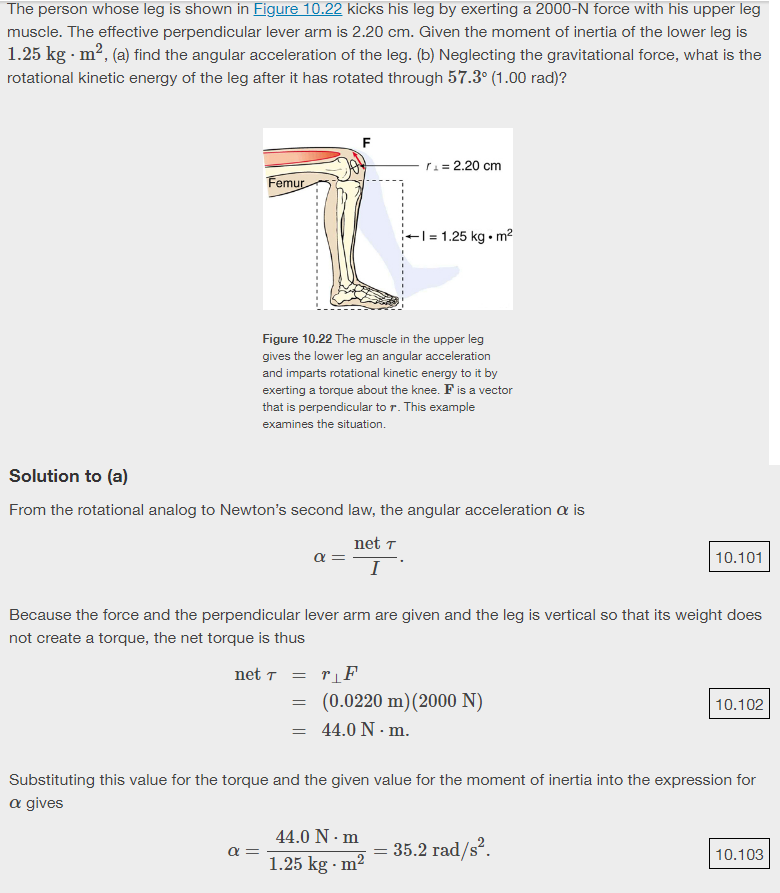[a] For Example 10.13 (Calculating the Torque in a Kick) in Section 10.5, replace "2000-N force" with "X-N force" where X is the number you computed on the first page of this study guide. Then solve part (a) of the example. There is no need to solve part (b). X = 883
[a] For Example 10.13 (Calculating the Torque in a Kick) in Section 10.5, replace "2000-N force" with "X-N force" where X is the number you computed on the first page of this study guide. Then solve part (a) of the example. There is no need to solve part (b). X = 883
University Physics Volume 1
18th Edition
ISBN:9781938168277
Author:William Moebs, Samuel J. Ling, Jeff Sanny
Publisher:William Moebs, Samuel J. Ling, Jeff Sanny
Chapter11: Angular Momentum
Section: Chapter Questions
Problem 54P: A cylinder with rotational inertia I1=2.0kgm2 rotates clockwise about a vertical axis through its...
Related questions
Question

Transcribed Image Text:The person whose leg is shown in Figure 10.22 kicks his leg by exerting a 2000-N force with his upper leg
muscle. The effective perpendicular lever arm is 2.20 cm. Given the moment of inertia of the lower leg is
1.25 kg - m2, (a) find the angular acceleration of the leg. (b) Neglecting the gravitational force, what is the
rotational kinetic energy of the leg after it has rotated through 57.3° (1.00 rad)?
F
r. = 2.20 cm
Femur
+\= 1.25 kg • m2
Figure 10.22 The muscle in the upper leg
gives the lower leg an angular acceleration
and imparts rotational kinetic energy to it by
exerting a torque about the knee. Fis a vector
that is perpendicular to r. This example
examines the situation.
Solution to (a)
From the rotational analog to Newton's second law, the angular acceleration a is
net T
a =
10.101
Because the force and the perpendicular lever arm are given and the leg is vertical so that its weight does
not create a torque, the net torque is thus
net T
(0.0220 m)(2000 N)
= 44.0 N · m.
10.102
Substituting this value for the torque and the given value for the moment of inertia into the expression for
a gives
44.0 N · m
1.25 kg · m2
= 35.2 rad/s².
a =
10.103
![3.3. In the OpenStax College Physics textbook, read the Chapter 10 sections 10.1 (Angular
Acceleration), 10.3 (Dynamics of Rotational Motion: Rotational Inertia) and 10.5 (Angular
Momentum and Its Conservation). Then write answers to [a] and [b] below.
For all your answers, please write down your calculations and explain your reasoning. Draw
sketches whenever helpful, and please use your units correctly. If you are using any online
resources (such as unit conversion tools) give their URL and webpage title in your answers.
[a] For Example 10.13 (Calculating the Torque in a Kick) in Section 10.5, replace “2000-N force"
with "X-N force" where X is the number you computed on the first page of this study guide.
Then solve part (a) of the example. There is no need to solve part (b).
X = 883
%3D](/v2/_next/image?url=https%3A%2F%2Fcontent.bartleby.com%2Fqna-images%2Fquestion%2F20154b36-3898-46e5-9631-3dc0bd928319%2F45217dbb-4e55-4b02-a3a7-f56ae1e2a9b9%2Fqt8nqyv_processed.jpeg&w=3840&q=75)
Transcribed Image Text:3.3. In the OpenStax College Physics textbook, read the Chapter 10 sections 10.1 (Angular
Acceleration), 10.3 (Dynamics of Rotational Motion: Rotational Inertia) and 10.5 (Angular
Momentum and Its Conservation). Then write answers to [a] and [b] below.
For all your answers, please write down your calculations and explain your reasoning. Draw
sketches whenever helpful, and please use your units correctly. If you are using any online
resources (such as unit conversion tools) give their URL and webpage title in your answers.
[a] For Example 10.13 (Calculating the Torque in a Kick) in Section 10.5, replace “2000-N force"
with "X-N force" where X is the number you computed on the first page of this study guide.
Then solve part (a) of the example. There is no need to solve part (b).
X = 883
%3D
Expert Solution
This question has been solved!
Explore an expertly crafted, step-by-step solution for a thorough understanding of key concepts.
This is a popular solution!
Trending now
This is a popular solution!
Step by step
Solved in 2 steps with 1 images

Knowledge Booster
Learn more about
Need a deep-dive on the concept behind this application? Look no further. Learn more about this topic, physics and related others by exploring similar questions and additional content below.Recommended textbooks for you

University Physics Volume 1
Physics
ISBN:
9781938168277
Author:
William Moebs, Samuel J. Ling, Jeff Sanny
Publisher:
OpenStax - Rice University

Physics for Scientists and Engineers: Foundations…
Physics
ISBN:
9781133939146
Author:
Katz, Debora M.
Publisher:
Cengage Learning

Principles of Physics: A Calculus-Based Text
Physics
ISBN:
9781133104261
Author:
Raymond A. Serway, John W. Jewett
Publisher:
Cengage Learning

University Physics Volume 1
Physics
ISBN:
9781938168277
Author:
William Moebs, Samuel J. Ling, Jeff Sanny
Publisher:
OpenStax - Rice University

Physics for Scientists and Engineers: Foundations…
Physics
ISBN:
9781133939146
Author:
Katz, Debora M.
Publisher:
Cengage Learning

Principles of Physics: A Calculus-Based Text
Physics
ISBN:
9781133104261
Author:
Raymond A. Serway, John W. Jewett
Publisher:
Cengage Learning

College Physics
Physics
ISBN:
9781938168000
Author:
Paul Peter Urone, Roger Hinrichs
Publisher:
OpenStax College

Glencoe Physics: Principles and Problems, Student…
Physics
ISBN:
9780078807213
Author:
Paul W. Zitzewitz
Publisher:
Glencoe/McGraw-Hill